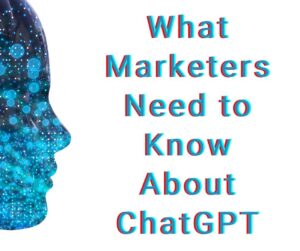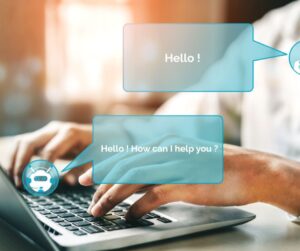What Marketers Need to Know About ChatGPT
 On November 30, 2022, ChatGPT, a natural language processing tool powered by artificial intelligence (AI), was unleashed on an unsuspecting world. Within a matter of weeks, it seemed that everyone had heard of it, with reactions ranging from enthusiasm to existential crises. Will ChatGPT render countless jobs obsolete? Or will it merely serve as a tool to help boost productivity in the workplace and in daily life, just like autocorrect, Siri, and other forms of AI? And given how quickly ChatGPT has seemed to revolutionize the human-AI relationship, how can we expect the technology to evolve in the future?
On November 30, 2022, ChatGPT, a natural language processing tool powered by artificial intelligence (AI), was unleashed on an unsuspecting world. Within a matter of weeks, it seemed that everyone had heard of it, with reactions ranging from enthusiasm to existential crises. Will ChatGPT render countless jobs obsolete? Or will it merely serve as a tool to help boost productivity in the workplace and in daily life, just like autocorrect, Siri, and other forms of AI? And given how quickly ChatGPT has seemed to revolutionize the human-AI relationship, how can we expect the technology to evolve in the future?
While there are currently no clear answers to these questions, one thing seems inescapable: AI is here to stay. For marketing professionals—as with those in most other industries—ChatGPT can serve as a helpful assistant for many tasks, although there are some notable limitations to be aware of. The following guide will offer insight into what marketers need to know about ChatGPT.
What is ChatGPT?
Created by OpenAI, an artificial intelligence research company, ChatGPT is the shortened name for Chat Generative Pre-Trained Transformer. What distinguishes ChatGPT from other forms of AI is its ability to engage with users in a natural, conversational way—responding to prompts and remembering previous parts of a dialogue—while drawing on its staggering knowledge of virtually any topic. ChatGPT is far more than a search engine: it does not simply restate text from elsewhere on the internet, but rather scans the countless books, online articles, and other sources from which it was trained and distills information into easy-to-understand snippets tailored to the user’s prompts.
But why try to explain ChatGPT in human terms, when it can speak for itself? After logging into my free account at https://openai.com (there is also a premium version available for $20 a month), I typed “What is ChatGPT?” into the dialogue box. This is the response I received:
“Hello! I am ChatGPT, a large language model developed by OpenAI. I am based on the GPT (Generative Pre-trained Transformer) architecture, specifically GPT-3.5. I have been trained on a massive amount of text data, which allows me to generate human-like responses to questions and prompts. I can answer questions, provide explanations, generate text, and engage in conversation on a wide range of topics.”
I then continued the dialogue with ChatGPT, asking it to suggest a catchy opening sentence for this blog (which I didn’t end up using, lest I contribute to the bot’s rapidly growing ego) and asking about ways that marketers can use ChatGPT to make their jobs easier.
Speaking of…
How can marketers use ChatGPT?
ChatGPT has several potential applications in the marketing world. For example:
- Content creation. As a language processing tool, one of the most obvious ways to use ChatGPT is in writing content. From blogs and email copy to social media captions and product descriptions, ChatGPT can quickly and coherently produce content based on specific prompts and other parameters (e.g., “Write a 1,000-word blog post explaining what marketers should know about ChatGPT. Use an authoritative tone.”) However, as discussed below, ChatGPT is not immune to errors, so it’s crucial to carefully proofread and revise anything it creates.
- Idea generation. In addition to crafting content, ChatGPT is great at coming up with
 ideas for topics that may be relevant to your audience. For instance, you might prompt it to “Give me 5 blog topic ideas for [your website URL]” or ask it, “What are some frequently asked questions that customers of (such-and-such business) might have?” Whether or not you implement the exact ideas ChatGPT gives you, it will likely help you brainstorm other ideas or provide a fresh perspective that minimizes the amount of time you spend researching what to blog or post about next.
ideas for topics that may be relevant to your audience. For instance, you might prompt it to “Give me 5 blog topic ideas for [your website URL]” or ask it, “What are some frequently asked questions that customers of (such-and-such business) might have?” Whether or not you implement the exact ideas ChatGPT gives you, it will likely help you brainstorm other ideas or provide a fresh perspective that minimizes the amount of time you spend researching what to blog or post about next. - Developing a marketing strategy. If you’re in need of ideas for marketing strategies and tactics, you can ask ChatGPT to “Help me develop a marketing strategy for [website URL, or a description of the company in question].” I sampled this with a client and found the suggestions to be fairly basic, but at the very least, it can offer a checklist to ensure that you’re covering all the different areas of your marketing strategy.
The limitations of ChatGPT
While ChatGPT’s ability to answer questions, produce content, and engage with users in a human-like way is impressive, it comes with several notable limitations—at least for now. When using ChatGPT as a tool in your marketing strategy or for any other purposes, be aware of the following:
- It may provide inaccurate information. At this point, ChatGPT cannot actively search the web to provide answers to your prompts—it was created using information from the
internet and other sources as of 2021, so some info may not be up to date. And as we all know, the internet itself is not always trustworthy, even when viewed from the perspective of a human with critical thinking skills. OpenAI acknowledges these limitations, stating, “ChatGPT sometimes writes plausible-sounding but incorrect or nonsensical answers.” Therefore, proofreading and fact-checking are critical. - The content ChatGPT produces can often sound a bit…robotic. For example, it tends to repeat ideas or even specific phrases several times throughout a response. Sentences can be choppy, and ChatGPT is particularly fond of starting blogs with some variation of “In this blog, we will discuss…” and ending them with “In conclusion…” (which, in my opinion, is reminiscent of a middle school student trying to follow a template for writing essays). Again, editing is key—not only to ensure accuracy, but also to “smooth out” the language so it sounds more natural and suits your client’s brand voice.
- ChatGPT may present ethical concerns. As a brand-new technology, businesses are still navigating the possible ethical concerns raised by ChatGPT. For instance, it produces content without citing sources, could potentially drift dangerously close to plagiarism, and may be prone to bias. While there are not yet clear rules on how to handle these concerns, marketing professionals should be conscious of them when relying on any ChatGPT-generated content.
To maximize the effectiveness of ChatGPT in light of its limitations, here are a few key takeaways:
- It might be helpful to think of ChatGPT as an unpaid intern: eager to help, but needing a great deal of supervision (in the form of proofreading, fact-checking, and refining).
- When using ChatGPT to create blogs or other web content, remember to take all the steps you normally would for SEO purposes—for instance, adding keywords, H1 and H2 tags, and internal links.
- Help ChatGPT help you. The more specific prompts you feed ChatGPT, the more likely it will be that you’ll get responses tailored to your needs. Additionally, if you’re not thrilled with the first response you receive, make the bot earn its keep! For example, ask it to recraft the response with a different tone or with a focus on different information.
And finally, to address a common concern about ChatGPT and other AI-related technologies: no, they aren’t taking our jobs. (Probably not. For now, at least.) While ChatGPT can serve as an effective assistant for brainstorming, creating content, and more, any marketing task is still in need of human oversight and the unique instincts that only sentient beings can bring.
Is your marketing strategy in need of a human touch? Contact the experts at LuCorp Marketing today to find out how we can help!
—Stephanie Vance
